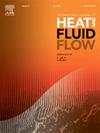Development and validation of two-phase flow & boiling module based on CorTAF framework
IF 2.6
3区 工程技术
Q2 ENGINEERING, MECHANICAL
International Journal of Heat and Fluid Flow
Pub Date : 2024-12-31
DOI:10.1016/j.ijheatfluidflow.2024.109739
引用次数: 0
Abstract
Two-phase flow and heat transfer characteristics under boiling condition possesses vital significance for pressurized water reactor (PWR) core design. Traditional system code or subchannel analysis code had been widely applied for safety analysis of reactor core, but the more elaborate distribution of three-dimensional parameters is unable to obtained. In this paper, a two-phase flow & boiling module is developed and implemented based on the previously proposed nuclear reactor core thermal–hydraulic characteristics analysis code CorTAF. The two-phase flow and boiling heat transfer analysis method under drift-flux model is established, combining constitutive model such as bubble formation, grid effect, turbulent mixing, coupled boiling heat transfer and the prediction of critical heat flux under diverse boiling states. The benchmarks including CE5 × 5 and PSBT are selected to perform the comprehensive code validation. Crucial physical parameters are compared with the experiment data. The maximum error of wall temperature is under 4 K in CE5 × 5, maximum error of void fraction and CHF in PSBT is under 0.07 and 15 % respectively, indicating that the two-phase flow & boiling module implemented in CorTAF is capable for accurate prediction of two-phase thermal–hydraulic characteristics in reactor core. Additionally, to visually demonstrate the calculation result by CorTAF, a brief simulation of multiple assemblies under partial blockage is also carried out. This work provides valuable references for safety analysis under reactivity insertion accident and further studies on multi-physics coupling of reactor core.
求助全文
约1分钟内获得全文
求助全文
来源期刊

International Journal of Heat and Fluid Flow
工程技术-工程:机械
CiteScore
5.00
自引率
7.70%
发文量
131
审稿时长
33 days
期刊介绍:
The International Journal of Heat and Fluid Flow welcomes high-quality original contributions on experimental, computational, and physical aspects of convective heat transfer and fluid dynamics relevant to engineering or the environment, including multiphase and microscale flows.
Papers reporting the application of these disciplines to design and development, with emphasis on new technological fields, are also welcomed. Some of these new fields include microscale electronic and mechanical systems; medical and biological systems; and thermal and flow control in both the internal and external environment.
 求助内容:
求助内容: 应助结果提醒方式:
应助结果提醒方式:


